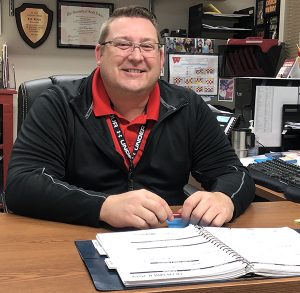
Rod Weber, superintendent of schools in Woonsocket, said small, rural schools face some unique challenges in hiring and funding, though Weber believes Woonsocket schools do a good job of creating an effective learning environment. Photo courtesy: Bart Pfankuch, South Dakota News Watch
Small, rural school systems in South Dakota and across the country face sometimes daunting challenges in providing a strong education to students.
Limited funding, difficulty in hiring and retaining good teachers, remoteness and transportation challenges, high poverty rates among students and reduced access to college-preparatory courses can all hamper learning in small, isolated school districts.
South Dakota is one of the most rural states in the nation when it comes to public education, with the vast majority of school districts located in rural areas and with 40 percent of students statewide attending rural schools.
Rural educators often tout the generally lower student-teacher ratios and close relationships formed between students and staffs, and scores on standardized tests show that students in some rural South Dakota districts match and occasionally outperform their urban peers.
But a new national study of small, rural school systems ranked South Dakota as fifth-highest in the nation in terms of challenges faced and need for improvement.
The study by the Rural School and Community Trust, titled “Why Rural Matters 2018-19,” used census information and data from the U.S. Department of Education and other sources in an attempt to shine a light on the need for states to focus more attention on and provide greater funding to rural schools.
“We do this study because rural schools and communities really matter to our nation, and they’re often forgotten,” said Alan Richard, a spokesman for the Rural School and Community Trust. “The financial and logistical challenges that rural schools face are really immense.”
The study found that nationally, nearly one in six rural students lives in poverty, that one in seven qualifies for special education and that one in nine rural students has moved in the past year. All of those factors put rural students at risk of falling behind or not graduating.
A high student-mobility rate is one of the factors hampering rural education in South Dakota, the study found. Researchers also said South Dakota is one of only seven states that decreased funding for rural schools in recent years, and that the state has a high rate of students living in poverty.
…Read on in this week’s issue of the Sanborn Weekly Journal!

Tweet